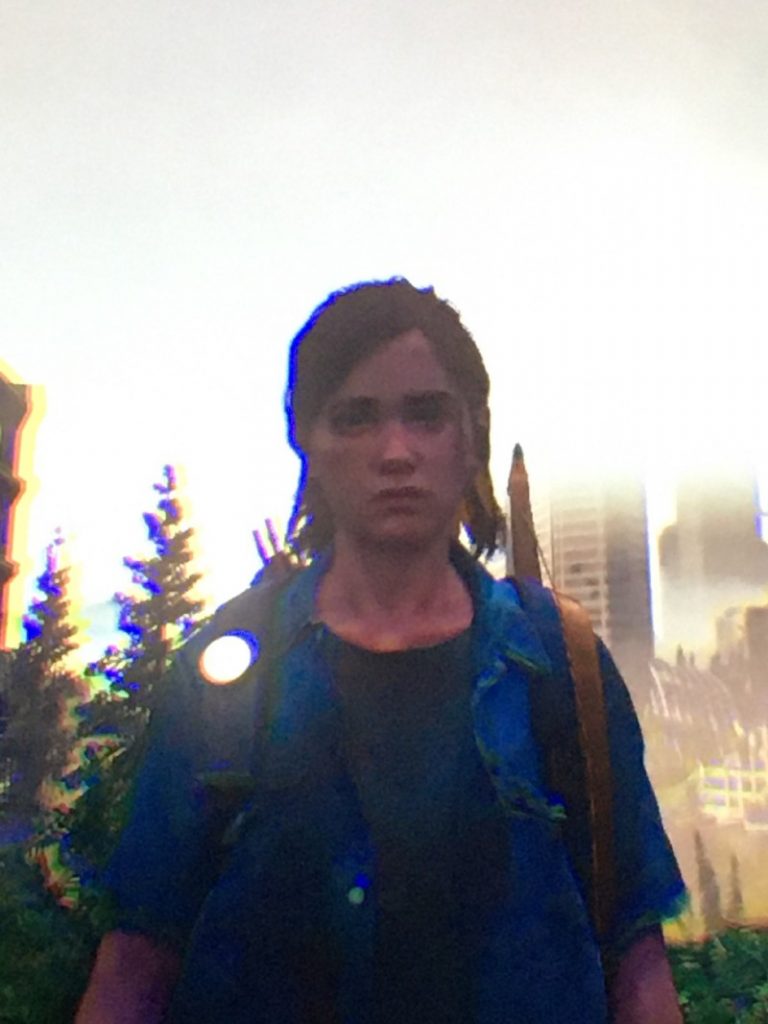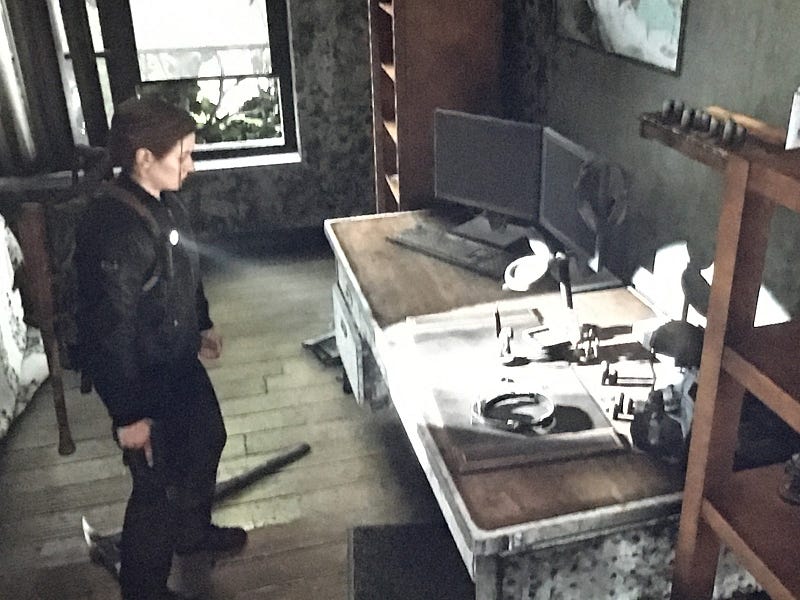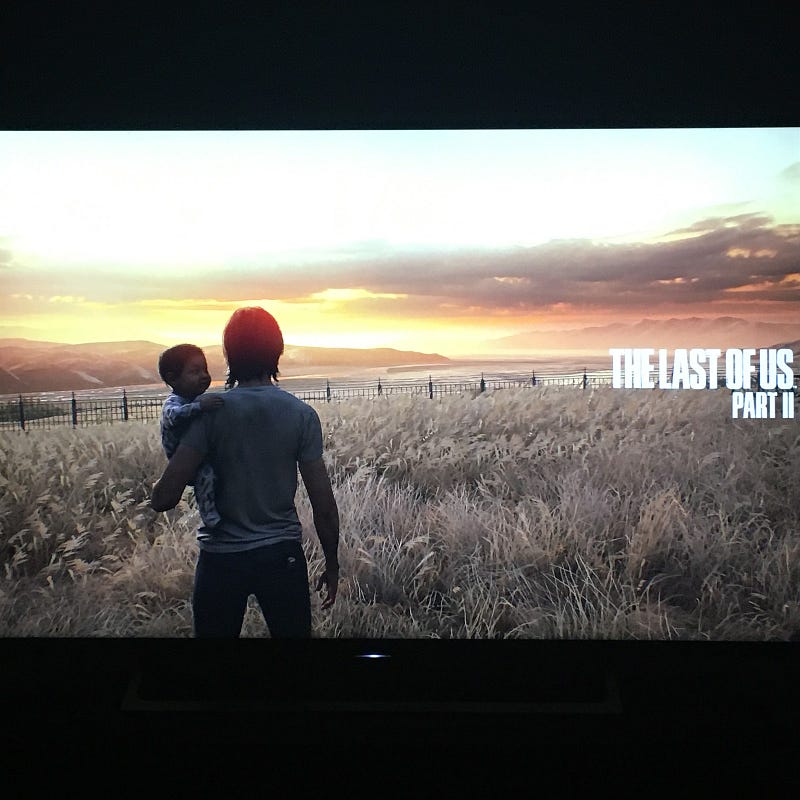The Last of PS4

Blurry Ellie (Photo by Austin Hall from The Last of Us: Part II)
Written By Austin Hall (@ADWAustin)
******************SPOILERS AHEAD**************************
The Last of Us Remastered edition was one of the first games I bought when I first got my PlayStation 4 (PS4), and while I wasn’t a huge fan (the last level was too hard for me), it seems appropriate that with PS5 on the way this fall, The Last of Us Part II would be one of the last games I bought on the system.
To that end, the experience of playing felt like the perfect send-off to seven years of gaming. In all the games I’ve played, this franchise is the only one that uses every ounce of the controller’s capabilities, from swiping with the touchpad to strum a tune, to the audio that emanates from the controller from the first game to hear voice recordings.
Part II flashes forward four years to an adult Ellie (Ashley Johnson) dealing with the realization that her father figure, Joel Miller (Troy Baker), took her away from doctors trying to use her immunity as a cure for mankind. Though you play as Joel in the first game, he dies in the first act of this one, making it clear that anyone can die in this story.
From the get-go, Part II feels less like a game and more like a multimedia experience. I don’t know if I’ve felt more of a seamless transition from the cinematic cutscenes to the gameplay itself as I have in this game. Many times I found myself still pressing a button before realizing that I could sit back and watch the gripping thriller in front of me, or the somber tension between two characters at a crossroads. That being said, there were too many scenes where the character falls through the floor and miraculously gets up, a trope that the Call of Duty franchise does a lot.
Even so, the gameplay is nigh perfect. Rarely do video games make me feel smart, but I learned through trial and error the grind of being patient as I fought off enemies. The result always led to a wave of celebration, not because I gunned everyone down (though that was almost always the case), but because I had outsmarted AI-driven humans or the rotting, zombie-like creatures with many names and levels of danger including Stalkers and Shamblers. For that matter, the game was always challenging and never too hard, always my biggest bugaboo. Twice, I killed off a grotesque monster to think “That’s it? I did it?… I did it!” Many times, I ran from too many enemies, only to learn that that was what I was supposed to do all along.
Even when I didn’t feel smart, and wasn’t sure what the game wanted me to do, they gave a helpful hint, keeping the game going so that I never got frustrated.
Throughout the game, you are in almost constant fear of what’s next, and whenever a Shambler would jump out at me, I would audibly gasp, especially when my character was killed. Yet, there were also many triumphs of using my last bullet on the last enemy, which was so rewarding. Though it is not an open-world game, every trinket you examined and letter you read fleshed out a world gone awry. It was a nice change of pace to inspect the state of things, whether it was looking at an abandoned but mostly kept apartment bedroom, or the decaying disorder of a once bright hotel. I found myself surprised at how long I would stay in a room and just look at a past life instead of rushing off to the next mission like I usually do when playing games.

Through this experience, I encountered a new concept as a gamer: playing as two main characters. One of them is Abby Anderson (Laura Bailey), the daughter of the doctor trying to use Ellie’s immunity as the cure, and Ellie herself. At first, it feels annoying to have to play the role of someone you don’t care about, but by the halfway point, I grew to root for Abby the same way I did for Ellie. There is a lot of backstory to get to with Abby, considering she was introduced in this game alone, and most of that backstory comes right before the climax of the game, where I felt like I was running through obstacles just to get back to seeing the characters point guns at each other. Still, it made me care about Abby and her story. By that point, the game progresses at a breakneck pace: Abby wants to kill Ellie because Joel killed her father, and Ellie wants to kill Abby because Abby killed Joel. As we hit the heartbreaking beats of making one try to kill the other, it becomes apparent that no one is completely right or wrong. I was certain they would make me kill Ellie, leaving me with dread as I stalked her through their theatre hideaway, and I felt hopeless as I kept holding onto the button that allowed Ellie to choke Abby within an inch of her life at the very end. I begged the game not to make me kill them, and thankfully, I didn’t have to.
That’s right: the final boss was no monster. Some might say it was Abby, but others could argue that Ellie is the monster. Who is right? Who is wrong? Is it both? These are the thoughts that linger with you well past the end credits.
Though the first game left on a heartbreaking note, it felt like the completion of a story, whereas this one felt like it was one cutscene too short. Maybe it’s because I like when stories wrap up naturally, and an ambiguous ending has never been satisfying to me, but it’s a compliment that the story had so much at stake that you never wanted it to end. I’d be shocked if we never get a Part III, but even if we don’t, what a ride it’s been. 9.5/10

Want to keep up with NerdCraft Nation? Follow us on Facebook, Twitter, and Instagram! You can also leave us a voice message!
Want to keep up with PubSquare Media? Follow us on Facebook, Twitter, and Instagram!



